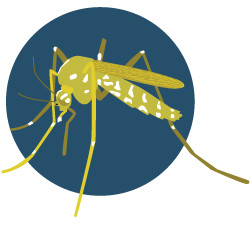- May 10, 2016
- By Chris Carroll
 Paul Leisnham didn’t grow up swatting mosquitoes in his native New Zealand, where the bloodsuckers are relatively uncommon and only a handful of species actually bite.
Paul Leisnham didn’t grow up swatting mosquitoes in his native New Zealand, where the bloodsuckers are relatively uncommon and only a handful of species actually bite.
But at the University of Maryland, the associate professor in the Department of Environmental Science and Technology is delving into the world of disease carrying mosquitoes to understand how they live and how to manage them.
With the looming threat this summer of a U.S. outbreak of Zika virus, an emerging mosquito-borne ailment that can cause serious birth defects, Leisnham spoke to Terp about Zika’s origin and how to control it—and warned against focusing obsessively on the scary disease of the moment.
TERP: What drew you to the study of mosquitoes in the first place?
Leisnham: I find mosquitoes fascinating because of their behavior—that they need to bite to obtain protein to lay eggs, which makes them good vectors of disease. They’re ecologically fascinating as well. They’re adapted to a wide range of habitats, they’re quite resilient, and they’ve got a complex life cycle, with the adults flying around biting people while the larvae mature in various water-holding habitats.

TERP: Where does Zika come from and how do mosquitoes spread it?
Leisnham: The origins of Zika are in Africa, and it is spread principally by the Aedes aegypti mosquito, commonly known as the yellow fever mosquito, which is very common in many parts of the Americas. It can spread if you have an infected human who’s bitten by a vector like Aedes aegypti, which then bites another human, and then there’s a snowball effect.
TERP: How does human behavior contribute?
Leisnham: Aedes aegypti is really good at breeding in little containers in urban environments. It’s commonly said that they can breed in a bottle cap. And these container-breeding mosquitoes’ lives are tightly coupled with human behavior. Humans can increase the amount of container habitats in the environment by having trash lying around, or having birdbaths or a planter in the back yard.
TERP: What’s being done to stop it?
Leisnham: It’s a complicated answer. America has had a long struggle with mosquito-borne disease. The historically problematic mosquitoes were ones that breed in large bodies of water like wetlands. The United States used to have malarial outbreaks and epidemics, so we spent over 100 years draining wetlands and spraying mosquitocides such as DDT and putting air conditioners and screens in our houses. It was really effective at reducing mosquitoes and associated diseases. But what we’re seeing in the last 30 to 40 years is that these small-container-breeding species from Asia and Africa are utilizing urban habitats. We haven’t been well prepared for that. A lot of municipalities, especially this far north, perhaps don’t realize the risk.
TERP: So… not much?
Leisnham: We’re very responsive and reactive. If there’s an outbreak of West Nile, it’s a big crisis, but we haven’t got the continuity of infrastructure and public health outreach to engage with communities and make them knowledgeable about mosquito- and other vector-borne disease to have continual effective management.
TERP: Could we just spray like crazy?
Leisnham: Chemical sprays don’t work very well for urban, container-breeding mosquitoes. Unlike spraying in an open area, the droplets don’t reach all the places where mosquitoes breed. In the last 30 years we’ve seen something called “integrated pest management” come into play where there’s less reliance on chemical sprays and a greater reliance on a broader suite of tools, including community-based management. That involves removing containers from back yards, educating people on repellents, educating people to stay inside at certain times of day when mosquitoes are active and so forth.
TERP: What’s Zika’s future in the United States?
Leisnham: In broad terms, with climate change and increasing average temperatures, we may expect to see the range of Zika-vectoring mosquitoes moving northward. They’ll probably be able to overwinter with greater survival, so during summertime they’ll be in higher abundances. But really, we don’t know yet. We don’t know the incidence rate of Zika and how that may change in space and time. I think this summer is going to be particularly interesting. If we see local transmission of Zika in the United States—that is, Zika circulating among mosquitos here rather than just being imported—I think we’ve got a really serious situation.

TERP: How much of the country is at risk?
Leisnham: The concern is primarily in the southern states, but the risk to the mid-Atlantic and the Northeast can’t be ignored. In addition to Aedes aegypti, we’ve also got Aedes albopictus, the Asian tiger mosquito, which is the most common urban mosquito in those regions. While it isn’t thought to be the principal vector of Zika, it has been shown to be a competent laboratory vector, so there is a potential, although much lower, for an outbreak to occur in the mid-Atlantic and Northeast.
TERP: Is there a socioeconomic component to risk?
Leisnham: There is an environmental justice issue involved. Low-income neighborhoods usually have much higher densities of trash. Our research has been looking at distributions of mosquitoes within cities across socioeconomic gradients. We find that low-income neighborhoods have much higher mosquito production. Because the mosquitoes that transmit Zika don’t fly a considerable distance compared to other mosquitoes—it may be about 100 to 150 meters—we may well see within an urban environment very distinct distributions of risk down to the city block scale.
TERP: How worried should we all be?
Leisnham: I think we need to temper the worries of the moment with a long view of the situation. Zika does provide concern to the continental United States, but we need to be more generally aware of the risk of invasive species and associated infectious disease, rather than just leaping from crisis to crisis. It used to be West Nile that was causing panic, then Chikungunya, now Zika. We perhaps need to have much more consistent awareness of the continual threats from vector-borne diseases.
Tags
Research